You used to be able to get a V6 in a Honda Accord sedan. But now that one’s a four cylinder-only sedan.
The good news is, there’s a new sedan made by Honda that’s available with the strongest V6 Honda ever put into a sedan.
The bad news is, it’s not being sold under the Honda label.
It’s the Acura TLX sedan – which means you’ll be paying premium bucks for the premium badge.
But at least you can still get it with a six.
And it also has some other stuff you can’t get in an Accord – like AWD. And it comes standard with much more power (and tech) than is available in the Accord.
The TLX is a medium-small sport sedan that competes most directly with the Audi A4 – which shares the same general FWD-based/AWD layout.
Other cars in the class – like the BMW 3 Series, Lexus IS, Cadillac CT4 and Genesis G70 are similar in size, price and general appearance but are based on rear-drive layouts, with AWD available optionally.
Prices start at $37,500 for the base trim, with a turbocharged, 272 hp 2.0 liter four cylinder engine, a 10-speed automatic transmission and front-wheel-drive; Acura’s Super Handling All-Wheel-Drive (SH-AWD) system is available optionally, bumping up the MSRP by $2,000 to $39,500.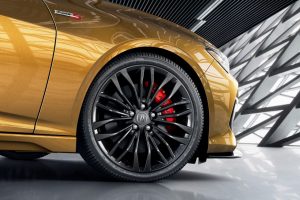
A Type-S with a turbocharged 3.0 liter V6 and the SH-AWD system will be available in May; Acura hasn’t released pricing numbers yet but this one will probably sticker for about $50,000 to start.
What’s New
The TLX is completely redesigned.
A much more powerful 2.0 liter turbocharged engine is now standard and an even more powerful turbocharged V6 is optional. All-wheel-drive is now available with the four, too. Previously, you had to buy the optional V6 to get AWD.
A ten-speed automatic is also standard with both of the ’21 TL’s new engines, replacing the previous eight and nine-speed transmissions that came with the four and the six, respectively, last year.
What’s Good
Much more muscular than before – with either engine.
You can still get a V6 engine.
With the four, it’s a deal relative to rivals in the class like the Audi A4 – which is also smaller and comes with a much less powerful standard engine.
You can only get the V6 in the Type-S variant, which is a much more expensive variant.
While the TL’s FWD-based layout has an advantage in terms of traction, it’s also the same basic layout you’ll find underneath cars that aren’t in the luxury-badged class (and price range). Most of the models in the TLX ’s price range, like the BMW 3 and the Lexus IS, are based on rear-drive layouts – which means you can light up the rear tires, if you’re into that.
Like all the cars in this class, the TLX has some needlessly overcomplex controls – such as the smartphone-emulating touchpad on the console. It can be as fumbly to use accurately while the car is moving as a smartphone.
The good news is you don’t have to use the touchpad to operate the climate controls or adjust the stereo.
Acura has upped the TLX’s game considerably for 2021.
The car now comes standard with a 272 horsepower 2.0 liter turbocharged four cylinder engine that is nearly as strong as the previously optional 290 horsepower 3.5 liter V6 and which produces more torque (280 ft.-lbs. at just 1,600 RPM vs. 267 ft.-lbs. at 4,500 RPM). This engine also massively outguns the Audi A4’s standard 2.0 liter, 201 horsepower four and also outpowers the Lexus IS series optional 3.5 liter (260 horsepower) V6.
It’s paired with a new 10-speed automatic transmission and you can choose either front-wheel-drive or the optional Super Handling All-Wheel-Drive (SH-AWD) system, which was not available with the 2.4 liter (206 hp) horsepower engine that was standard in the 2020 TLX.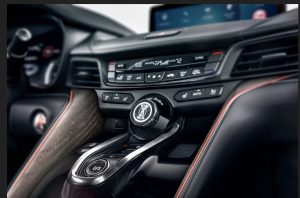
Surprisingly – given the horsepower (and torque) numbers – the TLX isn’t as quick as others in the segment, like the BMW 3 – which advertise less power but get to 60 in less than six seconds vs. close to 7 for the TLX.
Probably the reasons for this disparity include the TLX’s higher curb weight – 3,709 lbs. for the base FWD version vs. 3,560 for the BMW 3 sedan – and the way the standard 10 speed automatic is programmed, which is to maximize fuel economy, which is necessary to make the government happy.
The same government that has made six cylinder engines rare – and expensive.
To its credit, the TLX achieves almost the same city/highway mileage – 22 city, 31 highway for the FWD version – as the much less powerful and partially-electric (hybrid) Audi A4 manages, which is 25 city, 34 highway – a difference within the margin of error in real world driving and without the complexity or the expense of the part-time electric car drivetrain.
And Acura has the answer for those who want more power – and much more performance. The new Type-S variant comes with the most powerful V6 Acura has ever put into anything with four doors. It is also an all-new V6, turbocharged and displacing 3.0 liters. It makes 355 horsepower and nearly the same amount of torque (354 ft.-lbs.) which makes it comparable in output to a V8 (without a turbo).
It, too, is paired with the 10 speed automatic and the SH-AWD is mandatory. Equipped with this engine, the TLX lives up to its looks, getting to 60 in about 4.5 seconds – a time that makes it competitive with the M340i – the hopped-up version of the BMW 3 Series sedan.
It also makes it a deal compared with that one – assuming the unofficial MSRP of the Type-S turns out to be officially $50,000 or so – which would be several thousand less than the M340i’s base price of $54,700.
The TLX’s charm isn’t speed; it is tenacity.
Acura’s Super Handling All-Wheel-Drive system is about grip, particularly in the curves – which it enhances by applying power side to side as well as the usual front-to-rear. This torque vectoring adjusts for both understeer (the tendency, especially of FWD cars, to track too deep into the curve during high-speed cornering) and oversteer (the tendency, especially of rear-drive cars, to swing wide – tail out – as they approach the limit of grip in a curve taken at high speed).
The goal being neutral handling – neither over-nor-understeering. Which is what you get here and how you make up for the speed in a straight line that the Acura hasn’t got relative to its faster-accelerating rivals.
It is true that in the hands of an expert driver who knows how to drive a car sideways in a curve, an oversteering-tending rear-drive car like the BMW 3 can outpace a car like the TLX because at the limit, the rear-drive car is more balanced. But for most drivers, the TLX will feel safer going faster and probably be real-world faster than a car like the BMW 3 driven by someone who hasn’t got the skills or the nerve to go sideways through the curves.
The car’s main weakness in real-world terms – in performance terms – is probably the 10 speed automatic, which has ten speeds not for performance but to achieve higher mileage, which is kind of an absurd obsession in this class. People who are “concerned” over gas mileage – especially when we’re talking about differences of three or four miles-per-gallon – aren’t usually people who spend $40k-plus on a luxury-sport sedan.
But the government is very concerned.
Which forces Acura – and every other car maker – to express its concern by resorting to expedients such as transmissions with 10 rather than four or five speeds, the last several speeds being overdrive speeds – all for the sake of those three-or-four extra MPGs.
Such transmissions are also programmed to jump up into overdrives (plural) as quickly as possible, to cut engine revs and thus increase MPGs. But all this shifting up and down takes time. So does all the thinking – of the computer, as it decides which gear is the right gear. It’s time measured in fractions of a second, of course – but that manifests in how the car feels, how the engine responds. It is almost certain this car would be noticeably quicker and feel much quicker if it had a five-speed automatic and were programmed for performance rather than mileage.
But for that to happen, the government will have to get out of the car designing (and gas mileage decreeing) business.
The government is also why the V6 – once commonly available in Honda sedans – is now a very exclusively priced Acura engine.
The $50k-plus price assures not many will buy one, which perversely helps Acura – by not depressing Acura’s “fleet average” MPG numbers too much. A handful of Type-S variants that only rate 20 city, 25 highway (likely approximates for the 355 hp V6) won’t cause Acura to be socked with “gas guzzler” fines – or at least, lower fines – thereby making it easier to sell more of the four cylinder versions while still at least being able to offer the V6, for the handful of lucky buyers affluent enough to be in a position to afford it.
You may have noticed how racy new sedans are looking – even formerly conservative-looking family sedans like the Accord. Their designers have been focusing on how they look because of how functional crossovers and SUVs are. They can afford to look pretty much the same, because they sell on practical rather than aesthetic considerations.
The new TLX looks really racy.
Scalloped hood, strong pleats arcing along its flanks. The Type-S variant is even racier-looking, especially from the rear – where four cannon-sized exhaust pipes project from the lowered rear diffuser panel. It also sits hunkier on huge 20×9-inch wheels with super-low-profile summer tires mounted.
What’s ironic about all this show is that the TLX is actually a pretty practical sedan – certainly relative to several of its rivals, including the Audi A4 and the Lexus IS. For example, the Acura has 13.5 cubic feet of trunk space vs. 10.8 in the Lexus IS and 12 in the Audi.
It also has 34.9 inches of rear seat legroom vs. 32.2 in the Lexus IS. 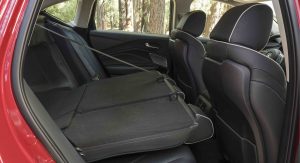
Both rear seats fold forward, too – creating a large pass-through that significantly increases the viable-cargo-carrying capacity of the TLX.
The Acura is also a larger, more substantial-looking car than either of these rivals. At 194.6 inches long it nearly qualifies for mid-sized status while the A4 (187.5 inches long) and Lexis IS (185.4 inches long) are firmly in the compact-sedan class.
Ditto the BMW 3 sedan, which is also only 185.7 inches long.
Acura’s strategy appears to be to offer more car – literally – for less money.
This Acura also still has an analog (non-LCD) main gauge cluster, which those who prefer that layout will . . . prefer. There is less configurability, but also less confusion.
There is a large and standard (10.2 inch) secondary LCD screen for the infotainment, with a touchpad controller on the center console – but several key functions, such as making climate control and stereo volume adjustments, can be controlled manually, using knobs and steering wheel buttons.
If you’d like an even racier-looking TLX but don’t want to spend the $50k for the Type-S variant, Acura offers most of the Type-S looks in a less-pricey A-Spec appearance package. It includes a flat-bottomed sport steering wheel, suede and brushed aluminum trim plus an exceptionally good 17 speaker, 710 watt ELS ultra premium audio system with twin Telford subwoofers (standard in the Type-S).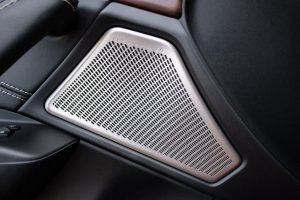
You can also buy an adaptive suspension system that’s similar to what you’d get if you bought the Type-S variant, just not as adjustable.
Heated rear seats and a Heads-Up Display (HUD) are also available.
The Rest
It’s a measure of the state of things that cars like the TLX – and the BMW 3 and others in the same class/price range – which used to come standard with six cylinder engines because economy cars came standard with four cylinder engines now come standard with four cylinder engines. Turbos have made these fours more powerful than the fours in economy cars, but nonetheless, a certain prestige is lacking. Which galls given you’ve certainly paid for it.
How much racier would this TLX be with the V6 standard? How much more appealing would it be vs. four cylinder-powered economy/family sedans?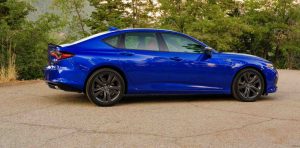
It’s sad that sixes are become the indulgences of the very affluent who can afford to spend $50k-plus on a car when once upon a time and not so very long ago, they were givens if you spent $35k on a car.
On the upside, the V6 is still available. And it costs less – looks like – than the six cylinder versions of rivals like the BMW M340i, especially when you factor in that the Acura’s six is paired with AWD standard whereas it’s optional in the BMW. With its extra-cost xDrive AWD system, the price of the M340i rises to $56,700.
It’s also interesting, cross-shop-wise, to observe that a Mercedes CLS450 sedan – which is only slightly larger (194.6 inches long) than the TLX and only slightly more powerful (362 horsepower from its turbocharged six) is massively more more expensive, $70,300 to start.
If the Type-S stickers for just over $50k, it’ll be the deal of the bunch.
The Bottom Line
Sedans are a tougher sell these days but Acura hopes a sedan that’s a bit larger and a lot stronger than its comparably priced rivals will sell.
We’ll soon know.
. . .
Got a question about cars, Libertarian politics – or anything else? Click on the “ask Eric” link and send ’em in!
If you like what you’ve found here please consider supporting EPautos.
We depend on you to keep the wheels turning!
Our donate button is here.
If you prefer not to use PayPal, our mailing address is:
EPautos
721 Hummingbird Lane SE
Copper Hill, VA 24079
PS: Get an EPautos magnet or sticker or coaster in return for a $20 or more one-time donation or a $10 or more monthly recurring donation. (Please be sure to tell us you want a magnet or sticker or coaster – and also, provide an address, so we know where to mail the thing!)
My eBook about car buying (new and used) is also available for your favorite price – free! Click here. If that fails, email me at [email protected] and I will send you a copy directly!


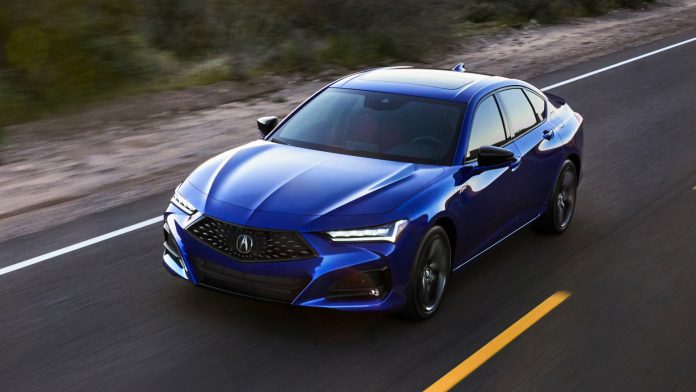

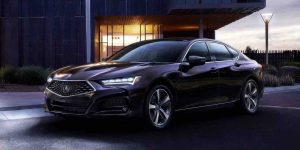
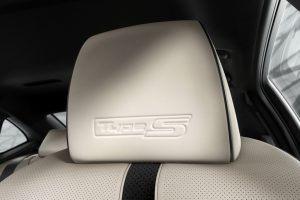











Reading all this, especially Cheddar’s comments, makes me happier than ever with my old pickup truck and older Suburban. Sure, it looks nice, it’s got all the latest drive train and entertainment technology, and it’s so damn complicated that I have serious doubts about its repairability a few years down the road. I have the same doubts about my wife’s new 2021 Jeep Cherokee Trailhawk. So far it’s great-except for that odd noise from the front right when you goose it off the line. Hey, at least it will be a warranty repair, right?
Ditto, Freeholder –
I love my old (2002) pick-up. It has just two airbags – and one of them turns off – and no LCD touchscreen. Probably why it is still running just as reliably today as it did 19 years ago!
I was glad to see that you found this car to have some redeeming value in the strange new world we inhabit. I work at an Acura dealer as a master technician, so here are a few random thoughts.
Honda has really gone all in with this new turbo 2.0 engine. Meaning they decided this is their new bread and butter and decided to install it in just about everything. Compared to previous iterations of Honda four cylinders it does provide a good deal of power that is noticeable immediately, even with mild throttle. Honda used to be known for four cylinders that you had to wind out to damn near motorcycle RPM’s to get any juice out of them. No more.
The latest generations of nine and ten speed transmissions are a work in progress. It is known. We were using the ZF nine speeds previously but Honda has finally developed their own for the latest versions. Honda has always been skeptical to dip their toes in the new technology waters, going back since forever. I believe the first Acura V6 was a joint venture with Land Rover?
I actually tore a 2.0 liter turbo engine apart in an RDX for a one off issue. Even as an expert mechanic these things are NOT easy to wrench on. There are a ton of small sub-procedures that make it a huge time suck to repair. As an example the side motor mount has about ten bolts and requires a sequential torque procedure. For a fucking motor mount. Good grief. Even getting the valve cover off is an exercise in patience.
I’m also a bit skeptical of these 2.0 liter engines. Whenever you drain the oil it reeks heavily of fuel dilution. The one I tore apart was already starting to sludge up a bit, and this is an engine with 20k running Mobil 1 that has already had a handful of oil changes. We’ll see if Honda figures this out but it doesn’t bode well for long term reliability!
I just saw that Honda won’t be going all in on electric vehicles until at least the 2024 model year. Unfortunately they decided it will be a joint venture with GM when it does come along. Say a prayer for us.
Morning, Cheddar!
I appreciate your hands-on input about the new Honda turbo four. I personally would rather have the old V6 – without the turbo(s) and without the direct injection. The naturally aspirated/PFI Honda V6 was – as I’m betting you’ll agree – a damned fine engine, not only in terms of the intangibles (sound/feel) but also the tangibles (they ran almost forever assuming even semi-decent care).
DI is something I’m very ambivalent about, as well as transmissions with 8,9 and ten speeds. I see no useful purpose – and lots of downsides. Curious to get your thoughts on that…
Regarding your opinion of the V6, I believe you’re spot on. Damn good motors. Should probably add an asterisk to that claim though. The 3.7 versions from about a decade ago have a propensity to get sticky piston rings and burn oil heavily. Interestingly enough they’ll often continue to run just fine, even though people are driving around with two quarts of oil in them (sometimes less) The only way most people realize they’re low on oil is that the oil light will start flashing on, which of course means it’s damn near empty. Fill it back up and keep driving. The other versions of the V6 (3.0, 3.2, 3.5) never had that issue.
Likewise not a fan of the Honda DI system. It’s noisy as hell and whenever I pull off the intake on one of them the valves always have heavy carbon buildup. The buildup has to affect performance but so far we haven’t really seen any issues with it causing mechanical problems. The DI system, however, hasn’t been any less reliable than the older setup for the most part.
The transmissions. I live in Minnesota and the ZF in particular does not like to operate very well until the fluid is up to temp. They’ve been fairly reliable but whenever I drive one I still don’t like how they shift. Certainly beats a CVT though, which I’m glad Acura has decided to ignore over the years. I’m still driving an older Acura with the five speed auto and that is perfection to me!
One more thought before I go. We used to run ‘new car clinics’ for new Acura owners. They got a presentation from the staff, some free schwag, service coupons, etc. And then there was a Q&A afterwards. They could come back in the shop and look underneath the car, ask us mechanical questions, whatever. Starting about six-eight years ago nobody came back in the shop. They have no care about what’s ‘under the hood’ anymore. The one and only primary concern of just about every buyer now is the dash electronics and how it ties in to their phone. Our number one service complaint with new cars is……phone connectivity issues.
Hi Eric, Today I finally pulled my 2013 Infiniti g37s coupe out of hibernation for an hour romp around the area. I Love this car with the 3.7 liter naturally aspirated V6. The VQ37VHR engine is truly a marvel of engineering. It allows for decent fuel economy but when I stand on it, it is quite ferocious! The 7 speed automatic is ok, but like all of the new cars it has 2 overdrives, and is programmed to get there. But, there is Sport mode, hee hee! It has only 20k miles on it, so I plan to enjoy it for many years.
I guess acura finally caught up to the kia stinger. Im a huge fan of hondas motors not a fan of their automatic transmissions. Acura finally caught up to the pack with the type s. They need more power or a loeer price point
I drive a 2018 Acura TLX. I love driving it. It’s a really nice car. It’s got the 3.5 liter 290 horsepower engine. The 2021 TLX has downsized the engine from 3.5 liters to 3 liters, added a turbocharger, added an extra gear to the automatic transmission, and raised the sticker price by about $15000. I’m not sure that this is an improvement!
Hi Martin,
The new Type-S variant does have 355 horsepower – and it’s quicker than your ’18 – but your point is well-taken. I think Acura would sell more of these if the price were closer to $40,000 for the Type-S than $50k-plus. But the problem then would be the effect of lots of V6 sales on Acura’s CAFE numbers.
And they ask me why I drink…
Hi Eric,
I guess the extra horsepower comes from the turbocharging. But as you’ve pointed out, turbocharging is not without its costs. The turbocharger is just one more thing that can break as the car gets older. Can a turbocharged engine last as long as a non turbocharged engine? Also, the turbocharged engine probably requires 91 octane gas. With my car, I’m using 89 octane gas and it seems to be running fine.
Martin
Hi Martin,
Yup. Turbo-supercharging (whether exhaust driven or belt driven) increases the effective displacement of the engine by increasing the airflow through the engine. The incoming air/fuel charge is compressed, leading to a denser charge and so more power when ignited inside the cylinders. Of course, this increases cylinder pressure as well as the load on all reciprocating parts, so they must be made stronger to handle it. There is also, as you point out, the additional complexity (and the additional parts) which in the nature of things generally increases the odds of eventual failure of one or several parts, etc.
In the past, turbos and superchargers were used chiefly as power increasers in high-performance cars, where more power trumped considerations of cost/complexity and long-term durability. People who bought a car like a Porsche 911 turbo being mainly concerned about more power and also people who generally didn’t drive such a car every day.
But the pressure imposed by government to “comply” with ever-upticking MPG mandates as well as reduce carbon dioxide “emissions” has made turbos the go-to expedient to maintain power otherwise lost due to downsizing of engines in family cars and even economy cars. As you know,it is common now to find 2.0 liter four cylinder engines in cars like the TLX, which in years past came standard with a V6 in the 3.5 liter range. The smaller engines have turbos to compensate for the lost power and some even offer more power than the V6 engines they replaced, as a way to get people to be more accepting of the general going-away of V6 engines. These smaller, turbocharged engines are on-paper capable of using less gas (when off-boost) and emit fewer gasses (when off boost) due to their smaller displacement (less airflow, etc.) but in real-world use, these are debatable gains because the engines are often on-boost, to make the power they would otherwise not deliver.
I personally consider it much more sensible to simply have the larger, simpler, less stressed V6. But that is based on sensibility rather than political considerations!
2500 rebates already on the all-new TLX. No one is interested in sedans unless they have a German badge on them, which is a shame as the TLX is a really nice car. My dad loves his, upgraded from an Accord.
Hi Anon,
It is a shame; even more so that Acura has to sell this car as an Acura. That Type-S V6 should be available in the Accord.
Of course, it might not sell even then because – as you say – sedans aren’t selling. Because people no longer care about driving. They just gawp at the apps and want an auto-raising tailgate in their latest all-look-the-same crossover.
Lessen in how to take a run car and make it like a rainy day at Disney. Still ok, but not worth the price of admission.
Really surprising at the acceleration numbers for the base 4 cylinder. In the TLX I had with the 2.4 I could get just under 7 seconds with only the 206hp. With about 70 more and a similar curb weight you would think they could get to the mid 6 second range pretty easily. I expect it is the transmission though as the 10 is probably the typical sluggish Honda product. I really liked the dual clutch in my car, but it was really hesitant to ever downshift, so much so that I found myself using the flappy paddles quite often. The 10 is probably even more so and I expect it does not respond too well to the paddles.
Hi Doug,
Yup; these multiple overdrive automatics are doing a number on performance/driving responsiveness… for the sake of MPG numbers. As with ASS, the gain is trivial for the owner but scaled up for CAFE,it matters – which is why these things are becoming ubiquitous.
I went to Denver last week, which meant going over Vail Pass on I-70. Normally I downshift to 3rd or 4th gear to keep the engine rev’ed up on the uphill side and to keep from freewheeling to ludicrous speed on the downhill side. The FCA 9 speed transmission has a manual-ish mode that will shift up to the selected gear but otherwise behave like it is in D. When I got to my destination in Denver I realized I left it in 4 the whole way to town. Checking the fuel economy it turned out I averaged 24 MPG. In “D” I usually see 20-22, mostly due to the M/S tires and junk on the roof rack. When I returned I set the transmission to 4 again, and sure enough 24 MPG.
These 10 speed transmissions are truly useless. One or two OD gears probably makes a difference. 6? No way will that matter. I only ever see the transmission go into 9th gear when I’m in Utah, where the PSL is 80, and even then only on downhill straightaway highway. But I guess the engineers can say they’re doing something and that’s got to be better than doing nothing.
Nice article, but none of these changes are to address what the American consumer wants, it’s all about appeasing “Uncle” and nothing more … (Oh and putting MORE lipstick on another pig)
NO SANE PERSON wants ALL of this electronic junk and guaranteed most don’t get past learning how to use the radio and the GPS …
Also, In comparison, I have a 1990 Dodge Daytona (only owner) and it has a Mitsubishi 3.0 V-6 5 spd manual and it STILL gets 38 MPG on the highway … ALL for $16K fully loaded when new.
Hi Walter,
I know… sigh… it is very frustrating. For all of us. As a potential buyer, I’d like to buy what I want – not what the government says I may have. As a car journalist, I’d like to see the car companies able to design cars based on what the market rather than government wants.
And they ask me why I drink.
Actually I do believe the Auto Mfgrs have a great deal of power to shape the market, but right now they don’t have the will to do so … I think they will eventually be forced to push back since it’s likely they will need to to stay in business as fewer and fewer Americans will be able to afford the “Luxury” of a fully tricked out vehicle (AKA expensive) …
Your article on Why Americans are going broke actually exemplifies what success for an auto company can be … the first one to break out, push back and offer a truly economy truck won’t be able to make enough of them to satisfy the market demand …
The auto companies are in an advanced state of regulatory capture. They take their cues from Uncle’s flying monkeys, most notably the saaafety brigade and the greenie weenies. They don’t make much money selling cars. They could fight it, maybe, by threatening to go bankrupt…that’s about the only card they have left to play…except it’s pretty clear by now that they aren’t allowed to do that either. And I’m not sure that would even work, because the greenies would count that as a win.
The only way out, is to tell Uncle to go stuff himself. That’s not going to come from Detroit. Toyota (in their own way) is trying, kind of.
Hi Publius,
It’s a difficult situation – in re the car companies. They are corporations and so for the most part, the management doesn’t give a flip except as regards quarterly returns and short-term profitability as they will be gone after just a few short years. And the buying public, for the most part, has been conditioned to at least feign interest in “safety” and “green” and so there’s that.
It’s the culture that’s responsible, at bottom. As with the Sickness Kabuki.
Eric,
I agree…partially. I don’t think the culture wants all this stuff, not really. At least, not most of it. I think the culture no longer knows how to keep all of the craziness relegated to the margins where it belongs.
Too many people are too well conditioned to go along with it, not to make waves, to avoid taking risks, to bow down to the “experts,” to ignore that little voice of common sense inside their heads.
People need to know that risk is where the adventure is, and that adventure brings rewards (not always monetary). And in this case, one of the biggest rewards would be some semblance of normal life.
Anyone who thinks we are going to mask or vaccinate our way out of this mess is a fool. The goalposts haven’t stopped moving yet, and people are beginning to notice that. I give it a couple more years, and things are going to start to collapse under their own weight.
Morning, Publius!
I hope this hysteria deflates eventually, too. But if not, so be it. I will do my best to remain an “old Roman” even as the barbarians sack what’s left of the Republic. Sanity is not statistical, after all.
Saaaaaaaaaaaaaaaaaaaaaaaaaaaaafety last.